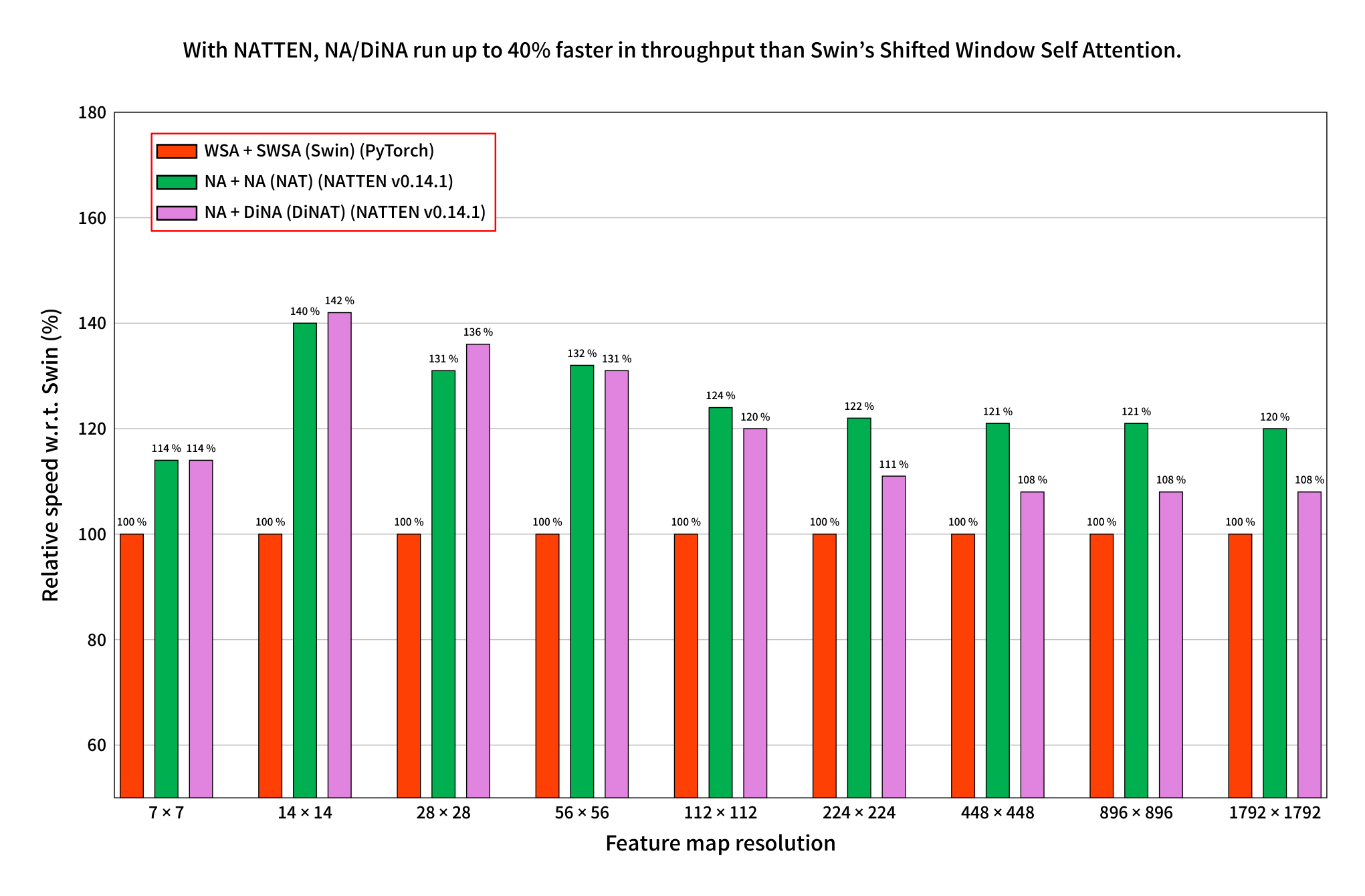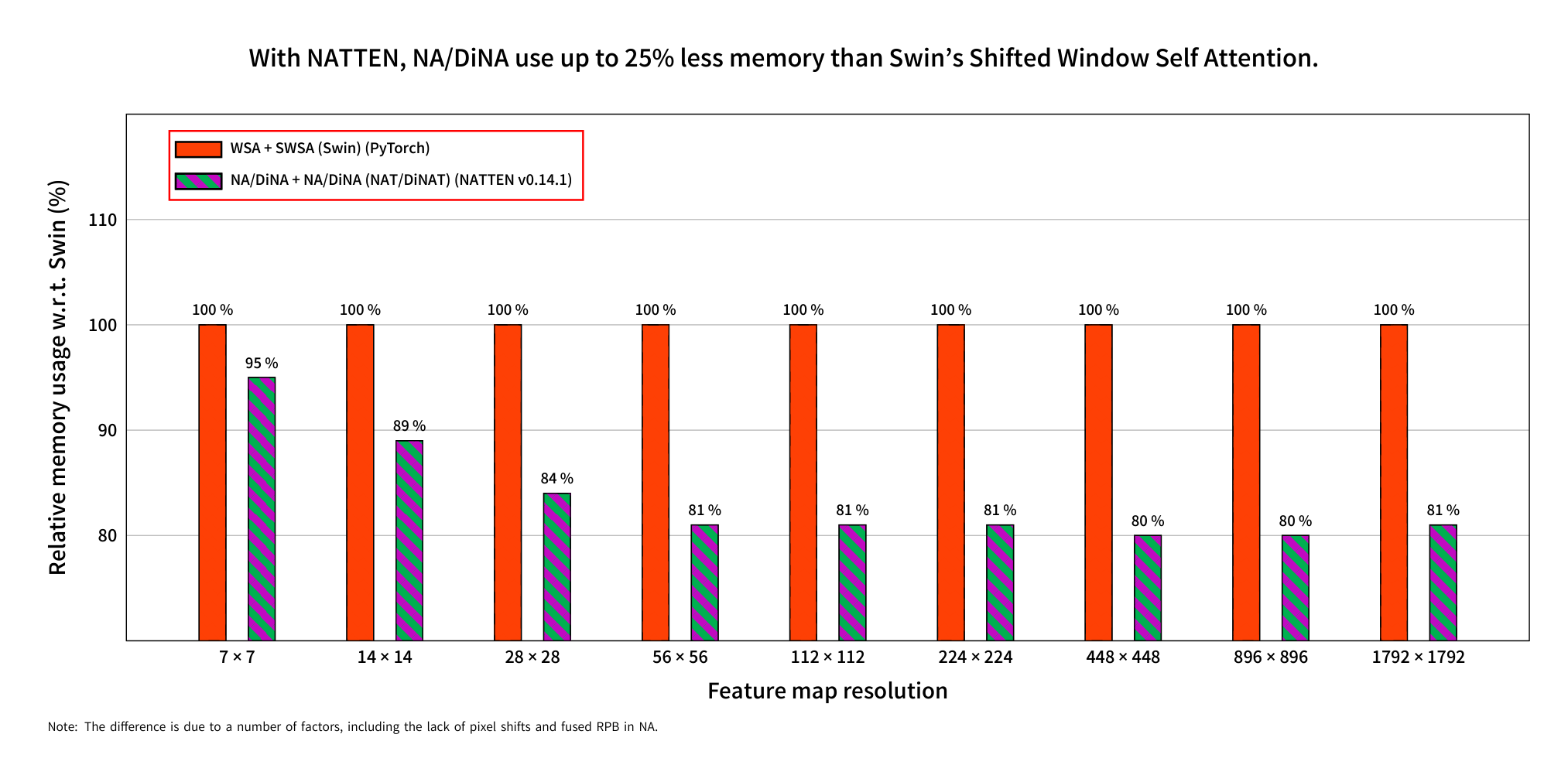Neighborhood Attention Extension.
Project description
Neighborhood Attention Extension
Bringing attention to a neighborhood near you!
NATTEN is an extension to PyTorch, which provides the first fast sliding window attention with efficient CUDA kernels. It provides Neighborhood Attention (local attention) and Dilated Neighborhood Attention (sparse global attention, a.k.a. dilated local attention) as PyTorch modules for both 1D and 2D data.
About NATTEN
Sliding window self attention mechanisms have been relatively overlooked, in part due to implementation difficulties. For example, in a paper proposing one of the earliest examples of such methods, SASA, it was noted that although such methods are theoretically efficient, they're relatively slow in practice, compared to convolutions, which have been implemented in most well-known deep learning libraries.
That is why we started developing NATTEN, an extension to existing libraries with efficient implementations of sliding window attention mechanisms, which will enable research in this direction including building powerful hierarchical vision transformers.
For more information, we highly recommend reading our preprints NAT and DiNAT, and check out their repository.
How fast is NATTEN?
The latest version of NATTEN runs pretty fast on Ampere with the latest torch and CUDA versions.

Requirements
NATTEN supports PyTorch version 1.8 and later, and Python versions 3.7, 3.8, and 3.9. However, we highly recommend using Python 3.8 and PyTorch 1.12.1 + CUDA 11.6 for the best performance.
NOTE: The current version of NATTEN comes with Linux-only wheels, and supports Pascal and above (SM >= 60, i.e. Tesla P100).
Make sure your GPU is supported by referring to
this webpage.
Future versions will extend support to older GPUs.
You may try and build from source on Windows, but do so at your own risk. We also welcome contributions in all forms.
Getting started
Linux
Just refer to our website, shi-labs.com/natten, select your PyTorch version and the CUDA version it was compiled with, copy-paste the command and install in seconds!
For example, if you're on torch==1.12.1+cu116, you should install NATTEN using the following wheel:
pip3 install natten -f https://shi-labs.com/natten/wheels/cu116/torch1.12.1/index.html
More generally:
pip3 install natten -f https://shi-labs.com/natten/wheels/{cu_version}/torch{torch_version}/index.html
NOTE: If you do not specify a wheel URL, you will install a "placeholder" version of NATTEN, which is not usable. We strongly recommend using our website, or building from source.
Windows
NATTEN should support Windows devices with CUDA, but does not yet have Windows wheels. You can try and build NATTEN from source (see below).
Build from source
Once you've set up your Python environment and installed PyTorch with CUDA, simply clone and build:
pip install ninja # Recommended, not required
git clone https://github.com/SHI-Labs/NATTEN
cd NATTEN
pip install -e .
Catalog
- Neighborhood Attention 1D (CUDA)
- Neighborhood Attention 2D (CUDA)
- Neighborhood Attention 3D (CUDA)
- Neighborhood Attention 1D (CPU)
- Neighborhood Attention 2D (CPU)
- Neighborhood Attention 3D (CPU)
- Dilation support
- Float16 support and utilization
- BFloat16 support
- Kepler and Maxwell (30<=SM<60) support
- Windows builds
Usage
Simply import NeighborhoodAttention1D or NeighborhoodAttention2D from natten:
from natten import NeighborhoodAttention1D
from natten import NeighborhoodAttention2D
na1d = NeighborhoodAttention1D(dim=128, kernel_size=7, dilation=2, num_heads=4).cuda()
na2d = NeighborhoodAttention2D(dim=128, kernel_size=7, dilation=2, num_heads=4).cuda()
FLOPs
We recommend counting flops through fvcore.
pip install fvcore
Once you have fvcore installed, you can directly use our dedicated FLOP counter:
from natten.flops import get_flops
flops = get_flops(model, input)
Alternatively, if you are using fvcore's FlopCountAnalysis directly, be sure to add our op handles:
from fvcore.nn import FlopCountAnalysis
from natten.flops import add_natten_handle
# ...
flop_ctr = FlopCountAnalysis(model, input)
flop_ctr = add_natten_handle(flop_ctr)
# ...
License
NATTEN is released under the MIT License.
Citation
@article{hassani2022neighborhood,
title = {Neighborhood Attention Transformer},
author = {Ali Hassani and Steven Walton and Jiachen Li and Shen Li and Humphrey Shi},
year = 2022,
url = {https://arxiv.org/abs/2204.07143},
eprint = {2204.07143},
archiveprefix = {arXiv},
primaryclass = {cs.CV}
}
@article{hassani2022dilated,
title = {Dilated Neighborhood Attention Transformer},
author = {Ali Hassani and Humphrey Shi},
year = 2022,
url = {https://arxiv.org/abs/2209.15001},
eprint = {2209.15001},
archiveprefix = {arXiv},
primaryclass = {cs.CV}
}
Project details
Release history Release notifications | RSS feed
Download files
Download the file for your platform. If you're not sure which to choose, learn more about installing packages.














